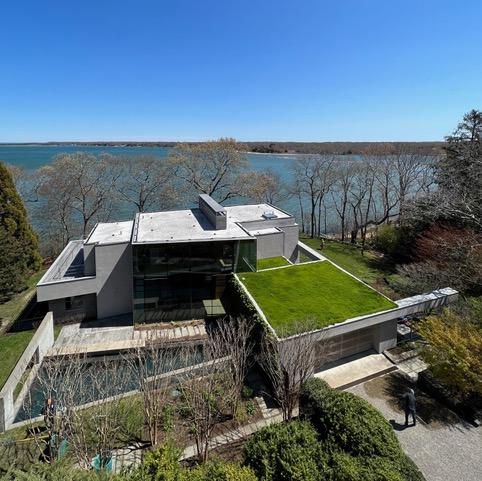The first thing Arthur Beckenstein sees when he steps out of his bedroom every morning is a lush spread of vibrant, earthy color. Maybe it's a textured greenish-brown in the winter, but come spring, summer, and fall, fresh pops of emerald, lime, yellow, purple, and red fill his field of view.
It's not a painting, though Mr. Beckenstein does have quite a few eye-catching works of art in his Northwest Woods house. Rather, it's a landscape — a rooftop garden atop a one-story section of his house, visible from the second-floor windows. A green roof, to be exact.
"It's one of the best decisions on this house that I ever made," said Mr. Beckenstein, a retired graphic designer, art director, and photographer who has lived in the Hampton Waters neighborhood since 1976. In fact, it's like having a Monet painting for a rooftop instead of "a bleak thing to look out on every day."
He installed it in 2018, and each year since, the colors have evolved differently.
"It's a surprise every year," he said, "but it's a delight throughout the seasons. It's quite beautiful. It has exceeded my expectations."
Besides the beauty factor, the first thing to know about green-rooftop technology is that when it's right, it's surprisingly low-maintenance. It doesn't need much in the way of irrigation, as long as it rains every so often. It doesn't need heavy fertilization either, or regular replanting.
The second thing to know is that there are multiple environmental benefits to having a green roof.
"It adds a little to your insulation, and it also reduces water runoff," said Maziar Behrooz, a Sag Harbor architect who has been credited with designing the first green roof ever installed in the hamlet of Montauk, in 2007. "If you have a rubber roof, when it rains, all the water runs down the gutters and carries down with it whatever there is. But with a green roof, it absorbs some of the water into the plants and gets recycled."
You can't exactly plant a tree on a roof, though. "Trees have big roots," Mr. Behrooz said. "You can't plant things that have big roots, so you have to be careful about what you plant and how much you're willing to go up there and prune and trim. We've also tried to turn them into vegetable gardens, but . . . you also need different soils and a handrail around the rooftop if you're going to be up there using the space as a garden."
It can add a few years of useful life to a roof when it's installed correctly, with proper membranes and waterproofing, according to George Irwin, a Rochester-based specialist who constructed Mr. Beckenstein's green roof. And what better way, Mr. Irwin asked, to offset the footprint of a structure within a landscape?
"What's beautiful about a green roof in a residential area is we are replacing the greenery that was removed," he said. "We're putting it back where it was, just higher."
The most common plant base for a green roof is sedum, a type of perennial with succulent-like leaves. It grows in shallow soil and requires lots of sun -- perfect for rooftop settings. The most efficient way to install it is in carpet-like sheets grown in nurseries, rolled up and then unfurled by landscapers after a roof has been properly waterproofed.
Mr. Behrooz has designed quite a few green roofs on the South Fork in recent years, including at the properties known as Arc House and Frog's Pond, both in Wainscott. Some were put in place by Mr. Irwin's Green Living Tech team, which owns seven U.S. patents for living wall and roof technology, has worked with contractors in 12 other countries, and partners with the Bronx Discovery High School to train students for careers in the field.
"When you add the green roof, your second floor feels grounded," Mr. Behrooz said. "There's a natural bed of plants right outside your window on a second floor — that's the biggest advantage."
"Flat rooftops, in the past, were just wasted space, especially in the Hamptons," Mr. Irwin said. A green roof "sure does make it nice, doesn't it?"

